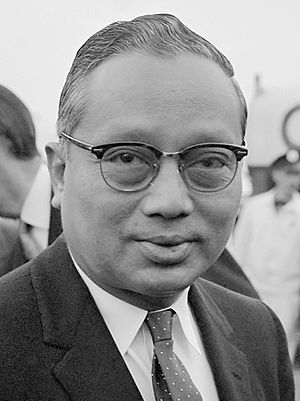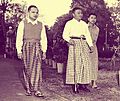U Thant facts for kids
Quick facts for kids
Thant
|
|
|---|---|
| သန့် | |

U Thant in 1963
|
|
| 3rd Secretary-General of the United Nations | |
| In office 30 November 1961 – 3 November 1966 |
|
| Preceded by | Dag Hammarskjöld |
| Succeeded by | vacancy |
| In office 2 December 1966 – 31 December 1971 |
|
| Preceded by | vacancy |
| Succeeded by | Kurt Waldheim |
| Personal details | |
| Born | 22 January 1909 Pantanaw, Burma, British India |
| Died | 25 November 1974 (aged 65) New York City, New York, United States |
| Cause of death | Lung cancer |
| Resting place | Kandawmin Garden Mausolea, Yangon, Myanmar |
| Nationality | Burmese |
| Spouse | Daw Thein Tin (died 1989) |
| Relations |
|
| Children |
|
| Parents |
|
| Signature | |
U Thant (born January 22, 1909 – died November 25, 1974) was a diplomat from Myanmar (formerly Burma). He served as the third Secretary-General of the United Nations from 1961 to 1971. He was chosen for this important role after the previous Secretary-General, Dag Hammarskjöld, sadly died in a plane crash in September 1961.
In Burmese, "U" is a word that means something like "Mister." "Thant" was his only name. People in Burma knew him as Pantanaw U Thant, which means "Mr. Thant from Pantanaw," because his hometown was Pantanaw.
Contents
Early Career and Public Service
After Burma became an independent country, U Thant began working for the government.
Working for the Burmese Government
In 1948, when U Nu became the Prime Minister of Burma, he asked Thant to join him in Rangoon. Thant was appointed as the Director of Broadcasting. The next year, he became the Secretary to the Government in the Ministry of Information.
From 1951 to 1957, Thant worked as the Secretary to the Prime Minister. He also attended many international meetings. He was the secretary for the first meeting of Asian and African countries in 1955 in Bandung, Indonesia. This meeting helped start the Non-Aligned Movement, a group of countries that did not take sides in the Cold War.
Becoming an Ambassador
From 1957 to 1961, U Thant was Burma's main representative, or Ambassador, to the United Nations. During this time, he helped with talks about Algeria becoming independent. In 1960, the Burmese government gave him an important award called Maha Thray Sithu, which is like being made a knight.
Leading the United Nations
U Thant took on the big job of leading the United Nations.
First Term as Secretary-General
U Thant started as Acting Secretary-General on November 3, 1961. He was chosen by all the countries in the United Nations General Assembly, after the United Nations Security Council recommended him. He filled the rest of Dag Hammarskjöld's term.
Then, on November 30, 1962, he was officially appointed Secretary-General for a full term until November 3, 1966. During this first term, he was praised for helping to calm down the Cuban Missile Crisis. This was a very tense time when the world feared a war between the United States and the Soviet Union. He also helped end the civil war in the Congo.
Second Term and Major Achievements
U Thant was chosen for a second term as Secretary-General on December 2, 1966. His second term lasted until December 31, 1971, when he retired.
During his time, many new countries from Asia and Africa joined the UN. He strongly opposed apartheid in South Africa, which was a system of racial segregation. He also helped create many important UN groups that work on development and the environment. These include the United Nations Development Programme (UNDP) and the United Nations Environment Programme.
He also worked quietly to prevent wars in places like Yemen in 1962 and Bahrain in 1968. His efforts helped stop these conflicts from growing into bigger regional wars.
Working with World Powers
Unlike the two Secretaries-General before him, U Thant was able to maintain good relationships with all the major world powers when he retired. In 1961, some countries wanted three Secretaries-General, one for each side of the Cold War. But by 1966, all the big powers agreed that having one strong Secretary-General was important. This showed how much they respected U Thant's work.
Key Global Events During His Time
Several important global events happened while U Thant was Secretary-General:
- The Six-Day War between Arab countries and Israel in 1967.
- The Prague Spring in Czechoslovakia and the Soviet invasion that followed.
- The Bangladesh Liberation War in 1971, which led to the creation of Bangladesh.
Challenges and Criticisms
U Thant faced some criticism, especially from the US and Israel. This happened when he agreed to remove UN troops from the Sinai Peninsula in 1967. This was at the request of Egyptian President Gamal Abdel Nasser. U Thant even flew to Cairo to try and persuade Nasser not to go to war with Israel.
His relationship with the US government became difficult when he spoke out against the Vietnam War. His secret attempts to arrange peace talks between the US and North Vietnam were rejected by the US government at the time.
U Thant was also interested in reports of unidentified flying objects (UFOs). In 1967, he arranged for a scientist named Dr. James E. McDonald to speak about UFOs at the UN.
Retirement from the UN
On January 23, 1971, U Thant clearly stated that he would not serve a third term as Secretary-General. It took many weeks for the UN Security Council to agree on a successor. Finally, on December 21, 1971, they chose Kurt Waldheim to take over. This was just ten days before U Thant's second term ended.
In his final speech to the United Nations General Assembly, U Thant said he felt a "great sense of relief bordering on liberation" as he left his demanding job. The New York Times newspaper praised him, saying his "wise counsel" would still be needed.
Death and Legacy
U Thant passed away from lung cancer in New York City on November 25, 1974.
Burial Controversy
At the time of his death, Burma was ruled by a military government. This government, led by Ne Win, refused to give U Thant any official honors. Ne Win was jealous of U Thant's international fame and the respect he had in Burma. He also disliked U Thant's close ties to the democratic government that Ne Win had overthrown in 1962. Ne Win ordered that U Thant be buried without any government involvement.
U Thant's body was flown back to Yangon (formerly Rangoon) from the United Nations headquarters in New York. However, no official guard of honor or high-ranking officials were at the airport when his coffin arrived.
On the day of his funeral, December 5, 1974, tens of thousands of people lined the streets of Rangoon to pay their respects. His coffin was displayed at a race course for a few hours before the planned burial.
Student Protests
Just before his coffin was to be taken to an ordinary cemetery, a group of students took it. They buried U Thant on the former grounds of the Rangoon University Students Union (RUSU). This building had been destroyed by Ne Win's government in 1962.
From December 5 to December 11, 1974, the students built a temporary tomb for U Thant on the RUSU grounds. They also gave speeches against the government. In the early morning of December 11, government troops attacked the campus. They killed some students, removed U Thant's coffin, and reburied it at the foot of the Shwedagon Pagoda. His tomb remains there today.
When people heard about the attack and the removal of the coffin, many rioted in the streets of Rangoon. The government declared martial law. This event, known as the U Thant crisis, involved student protests against the government's disrespectful treatment of U Thant. The Burmese government eventually crushed these protests.
In 1978, U Thant's memoirs, titled View from the UN, were published.
Named for Him
- The U Thant Peace Award recognizes individuals or groups who have made important contributions to world peace.
- A road in Kuala Lumpur, Malaysia, called Jalan U Thant, is named after him.
- A small island in the East River in New York, right across from the United Nations headquarters, is named for him.
- The U Thant Honorary Lecture is held regularly at the United Nations University (UNU) Headquarters in Tokyo, Japan.
| Preceded by Dag Hammarskjöld Sweden |
United Nations Secretary-General 1961 – 1972 |
Succeeded by Kurt Waldheim Austria |
Images for kids
-
Thant shakes hands with John F. Kennedy during his visit to the UN Headquarters.
See also
 In Spanish: U Thant para niños
In Spanish: U Thant para niños







